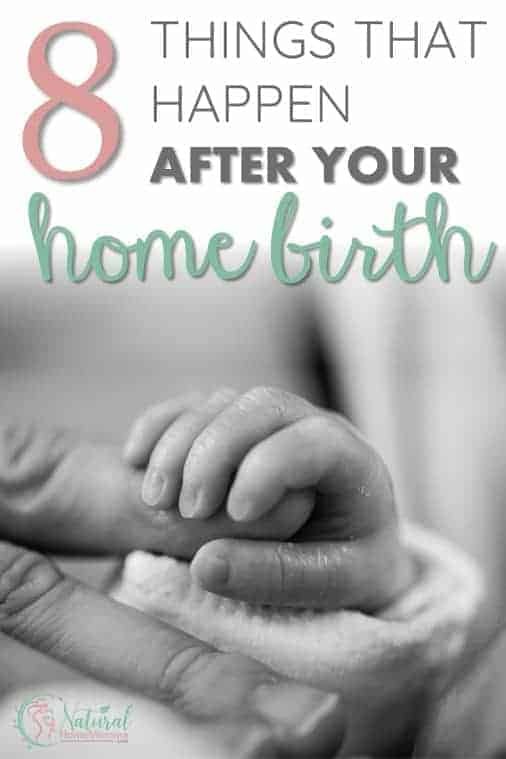
There is no doubt that home birth requires a lot of planning and preparing. The better prepared you are, the more educated and in control you will feel during such a life-changing event. Which is always a win, right?
Today, I’m here to make sure you don’t forget to think about what comes next. What happens after a home birth? How long does the midwife stay after a home birth? What paperwork do you need to take care of? What will you do in your first few days at home with your newborn?
Rest assured, your midwife is going to help you ease into your new role as a mother. She will stick around for a few hours after the birth to ensure you and baby are doing well physically, you’ve got a good start on breastfeeding, you’ve had a chance to get cleaned up, and eaten a nourishing meal.
She will do most of the birth clean-up and won’t leave until you are completely settled and feeling confident. And she’ll be on call 24/7 should anything come up after she leaves as well!
Let’s dive into the details a bit more so that you know exactly what to expect after your home birth.
1. Immediate Bonding and Delayed Newborn Care Procedures
One of the best parts of a home birth is the immediate and uninterrupted bonding you will have with your baby and partner. As long as baby has good color and sounds, you will be the only one touching baby for an hour or more after birth.
Newborn care procedures can and will be delayed at your home birth. Ah! The moment you’ve been waiting for at last, snuggling that newborn!
During this time frame you will also breastfeed baby for the first time. Usually, you will be able to follow baby’s cues when they are ready to nurse. Your midwife will assist you in getting a proper latch and positioning.
What does the midwife do immediately after baby is born at a home birth?
During this precious and valuable skin-to-skin time, your midwife will see that your placenta is delivered without complications. She will also assess any tearing that needs suturing.
If so, midwives generally carry local anesthetic and will be able to stitch you up all while you continue bonding with baby.
Newborn Care Procedures
After about an hour of uninterrupted bonding and your first feed with baby, your midwife will ask your permission to perform a newborn check and any desired newborn care procedures. This will include measuring baby’s length, weight, and continued monitoring of their vitals.
Most midwives are able to give Vitamin K and eye ointment if you wish for these procedures to be done. This is something to discuss with your midwife in the weeks leading up to your home birth. Read more about typical newborn care procedures to help with your decision.
Additional Newborn Care and Check-Ups
Outside of these procedures, you should discuss other newborn screenings such as hearing tests, PKU testing, hepatitis vaccine etc. with your midwife and your pre-selected pediatrician.
After your home birth, it will be important to have a home visit with your pediatrician in the days after birth. The exact timing and scheduling of this visit may vary from provider to provider so be sure to touch base with your pediatrician about your unique birth situation before you are due.
You should plan to contact your pediatrician soon after birth to schedule your first check-in with them. Many pediatricians will do home visits after home births.
2. Your Birth Team will do most of the home birth clean-up
A surprising amount of women are under the impression that they will be cleaning up their home birth, but this is usually not the case! Part of your midwife’s duties is getting things back to normal after birth.
She will change the sheets, clean up drop cloths, used towels and other linens. She will likely get a load of wash going if there are linens you plan on reusing, too.
As you complete your home birth checklist, it will be important to have organized clean-up materials for her to use. Most important are large black trash bags, large plastic bins to use for soiled linens, and hydrogen peroxide (which is awesome for removing blood stains!).
3. Get yourself cleaned up
In addition to getting the physical environment cleaned up from birth, your midwife will help you get cleaned up as well. She will support you in your first shower or bath after birth and get you into comfy postpartum clothes.
Your midwife will help you learn to care for your sensitive and sore body after birth. She will teach you how to use a peri-bottle to clean after using the bathroom. She will also show you how to set up a large pad with witch hazel wipes and an ice pack to aid in healing and soothe postpartum hemorrhoids.
4. Eat a nourishing meal
I know that immediately after giving birth I was insanely hungry! You will be burning an enormous amount of calories during labor and delivery. While you should eat light snacks during labor if possible, or at least drink electrolyte drinks, it’s difficult for most women to really eat.
The giant burrito I ate about an hour after birth was the best of my life (no exaggeration). My point here is that you will want and NEED to eat something filling and nourishing right away. Hopefully, you’ll have a well-stocked fridge with lots of options.
Many midwives are happy to help get you a meal, especially if it is easily prepared and stocked in the house.
5. Breastfeeding support from your midwife
Some of the most valuable information and support you can get from your midwife in the hours after birth will be with breastfeeding. In fact, many midwives decide when to leave based on how breastfeeding is going.
Ask lots of questions to ensure you feel confident!
Must ask breastfeeding questions include:
- How to achieve a proper latch?
- How to identify early hunger cues?
- What to expect when your milk comes in?
- What to expect in terms of diaper output from your baby (this is SUPER important)
- How often to breastfeed? (every 2 hours, minimum)
- How to position baby using your nursing pillow (it’s great to learn with one right from the start)
- How to track feedings (from the start of a feeding to the end of the feeding on both sides)
- Any red flags to look for that would indicate breastfeeding problems
Remember that breastfeeding is a learning curve for both you and baby! I was surprised at the fact that it really wasn’t as innate as I expected it to be.
Be persistent and it will feel second-nature in no time. Learning as much as you can about breastfeeding ahead of time will give you a serious leg up on this.
Breastfeeding support after your midwife leaves
Your midwife will be on-call 24/7 after birth. She will also be checking in during your postpartum days. Your pediatrician will also provide breastfeeding support and help you determine that breastfeeding is going well.
Keep in mind that Lactation Consultants are available for home visits. Remember this in the first days after birth if you are struggling with breastfeeding. Do not wait to get help!
Know about local breastfeeding resources ahead of time
One other tip I have is to seek out local breastfeeding resources before your birth so that you already know where they are. Find a local La Leche League meeting, look on google, and ask your pediatrician and midwife about breastfeeding support groups they know of in your area.
6. Paperwork after your home birth
When you give birth at home, it is important to fill out paperwork for your newborn to obtain their birth certificate and get a social security number. Most home birth midwives will be prepared with these forms and will submit them on your behalf.
You can choose to submit a form for only the birth certificate and apply for the social security number later, but it is much easier to apply for both at the same time.
This is another essential question for your midwife in the months and weeks leading up to birth. Because if for some reason they do not have the necessary paperwork or cannot submit it for you, you need to be sure to have it ready for your midwife to sign.
If this is the case, you will need to find forms for your state to register an out of hospital birth. You will then need to submit the forms to your local town hall/courthouse.
7. Discuss your postpartum care plan
One of the last steps after your home birth before your midwife leaves will be discussing your postpartum care plan. Your midwife will review how to care for yourself down there and what to expect in terms of bleeding. She will discuss what’s not normal and red flags that will warrant a call right away.
Above, I discussed breastfeeding at length, but your midwife will also include breastfeeding guidelines and red flags in the postpartum care plan. She will also make sure that you understand how to care for and monitor your newborn.
You can expect to see your midwife again for a visit 24 hours after birth. After that, women typically see their midwives 3 days after birth, one week after birth, and again 2-3 weeks postpartum. You will have your last postpartum visit around 6-8 weeks postpartum.
8. Soak up your first few days with your newborn
When you midwife does leave, usually 2-5 hours after the birth, you will be able to focus entirely on your newborn. The house will be put back together, you will be clean and refreshed, and you will have a good start on breastfeeding and your new role of mother.
The first few days after your home birth should be filled with rest and breastfeeding only. Be mindful and limited with who you allow to visit.
You and your partner need to monitor baby’s diaper output closely because this is your best indication that breastfeeding is going well and baby is getting what they need.
Above all, in these first few days, do not hesitate to call your midwife or pediatrician if ANY question arises. They are there to help you and no question is too small.
Now you know exactly what to expect after your home birth! Good luck, momma!


